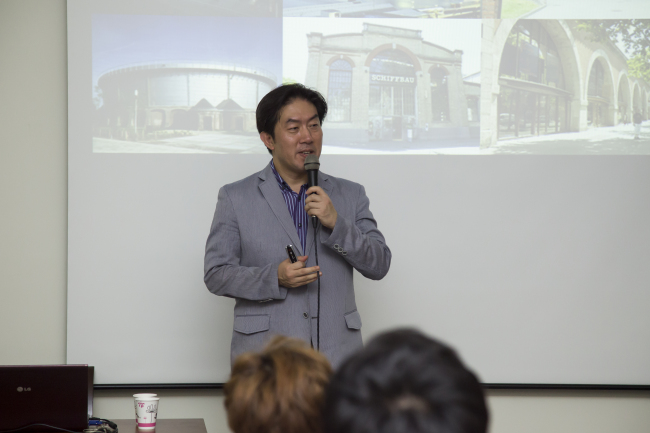Last month, an elevated road crossing located near Seoul Station officially closed down, signaling the beginning of the Seoul Metropolitan Government’s 23.2 billion won ($18.95 million) project to turn the decades-old structure into a high-rise public park.
Led by Seoul City Mayor Park Won-soon, the plan is aimed at transforming the 46-year-old overpass in central Seoul into a pedestrian park by 2017. The mega project is similar to the High Line Park in New York City, a landmark urban renewal case that revived an abandoned urban freight rail line for better public use.
 |
Kim Jeong-hoo (Courtesy of Kim Jeong-hoo) |
Despite Seoul city’s ambitious drive, the project is “being carried out too quickly and without sufficient time for necessary discussion and critical examination,” said Kim Jeong-hoo, an urban renewal expert and a research fellow at University College London’s department of geography.
“Urban regeneration is evaluated not only for its finished outcome but also for the entire implementation process,” said the scholar in an email interview with The Korea Herald, noting the project is “experiencing many trials and errors.”
The city government has been facing fierce opposition from local shop owners who fear a sharp decline in their businesses and commuters concerned over traffic congestion in the area. Some conservatives also have demanded the liberal mayor to clarify reasons for pushing the project, questioning his political motives.
Since announcing the large-scale urban renewal project, Seoul Mayor Park has been criticized for unilaterally bulldozing his way past dissent from local businesspeople, residents and traffic police to finish the project by 2017, the same year as the presidential election. The activist lawyer-turned-mayor is one of the presidential hopefuls from the main opposition party.
In response, Seoul City has been emphasizing that the derelict structure, which received a D-rating from multiple safety evaluations, was debilitating and needed to be demolished.
The city, home to nearly half of Korea’s population, has also set forth plans to build 17 connecting passageways leading into different regions around the 1.15-kilometer overpass, claiming they can draw more attention from the citizens and help revitalize spending in nearby areas.
Pointing at the project being implemented without getting full consent from residents and other involved parties, Kim said the core element of an urban renewal project should focus on the needs of the people who live and work in the area.
All forms of urban regeneration -- a reprogramming of existing, outdated urban spaces to serve necessary functions for the city -- must “foremost focus on the city’s inhabitants,” said the professor, who serves as an adviser to several Korean government-led urban regeneration projects.
 |
Construction is underway to transform a decades-old overpass near Seoul Station into a public park by 2017. (Yonhap) |
“Window-dressing urban regeneration projects that are unrelated to improving inhabitants’ quality of life are no different from outdated redevelopment agendas,” said Kim. “Close, multidimensional partnerships between the government and the public drive forward successful urban regeneration.”
Kim also raised concerns over Seoul’s lack of a clear plan for how to finance the management of the overpass park upon its completion.
The scholar, who initially began studying urban renewal led by his interest in “a healthier, sustainable development of the city,” believes forming effective, fitting urban renewal agendas is critical to the sustainable evolution of any city, which all differ in their unique history, identity and needs.
In the case of Korea, a country that achieved rapid industrialization and extensive urbanization in mere decades, “urban regeneration” by nature stands in opposition to the way that Korean cities were initially formed, Kim said.
Having built up its cities from the rubbles of war through compressed industrialization, “Korea is more accustomed to destroying and building anew rather than finding and retaining existing historical, regional and cultural values.”
“Though cities evolve in similar patterns, there are significant differences in the ways they degenerate,” said the UCL scholar.
“In other words, Korea must refrain from implementing the same urban regeneration methods of the West but rather develop its own urban renewal agendas after a careful evaluation of its cities’ urban degeneration patterns, structural layouts, housing patterns and so on.”
Kim resides in London where he teaches and conducts research on urban regeneration at UCL. He also heads his own institution JHK Urban Research Lab in the capital city.
The seasoned Korean scholar is also a special assignment professor at Hanyang University’s Graduate School of Urban Studies and carries out diverse lectures on urban regeneration in Korea during his regular visits to the country.
By Sohn Ji-young (
jys@heraldcorp.com)









